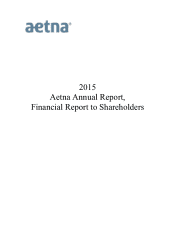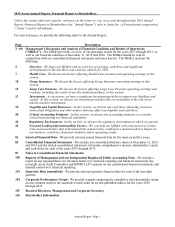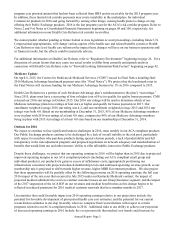Aetna 2015 Annual Report Download - page 10
Download and view the complete annual report
Please find page 10 of the 2015 Aetna annual report below. You can navigate through the pages in the report by either clicking on the pages listed below, or by using the keyword search tool below to find specific information within the annual report.Annual Report- Page 4
Health Care Reform
The Patient Protection and Affordable Care Act and the Health Care and Education Reconciliation Act of 2010 (as
amended, collectively, “Health Care Reform” or the “ACA”) has changed and will continue to make broad-based
changes to the U.S. health care system. We expect Health Care Reform and changes to Health Care Reform to
continue to significantly impact our business operations and financial results, including our pricing, our medical
benefit ratios (“MBRs”) and the geographies in which our products are available. Health Care Reform presents us
with business opportunities, but also with financial and regulatory challenges. Most of the key components of
Health Care Reform were phased in during or prior to 2014, including public health insurance exchanges (“Public
Exchanges”), required minimum MLRs in Commercial and Medicare products, the individual coverage mandate,
guaranteed issue, rating limits in individual and small group products, significant new industry-wide fees,
assessments and taxes, enhanced premium rate review and disclosure processes, reduced Medicare Advantage
payment rates to insurers, and linking Medicare Advantage payments to a plan’s CMS quality performance ratings
or “star ratings.” The effects of these changes are reflected in our financial results. Certain components of Health
Care Reform will continue to be phased in until 2020. It is reasonably possible that Health Care Reform and/or
changes to Health Care Reform, in the aggregate, could have a significant adverse effect on our business operations
and financial results.
On June 25, 2015, the U.S. Supreme Court issued a ruling that upheld the availability of federal tax credits and
subsidies to individuals who purchase health insurance through Public Exchanges established by the federal
government.
During 2015, we paid our $856 million portion of the ACA’s non tax-deductible health insurer fee (the “HIF”), an
$185 million portion of our estimated 2015 ACA reinsurance contribution and the remaining $60 million portion of
our 2014 ACA reinsurance contribution. During 2014, we paid our $605 million portion of the HIF and a $298
million portion of our estimated 2014 ACA reinsurance contribution. In the aggregate, we expect our portion of the
total fees, assessments and taxes imposed by Health Care Reform in 2016 to be approximately $1 billion. Refer to
Notes 2, 5 and 9 of Notes to Consolidated Financial Statements beginning on pages 88, 101 and 109, respectively,
for additional information on the HIF and the ACA’s reinsurance program.
Ongoing legislative and regulatory changes to Health Care Reform, other pending efforts in the U.S. Congress to
amend or restrict funding for various aspects of Health Care Reform (including risk corridors), the 2016 presidential
election, pending litigation challenging aspects of the law and federal budget negotiations continue to create
uncertainty about the ultimate impact of Health Care Reform. Examples of these legislative and regulatory changes
include: the December 2015 suspension of the HIF for 2017 and two year delay of the “Cadillac” tax on high-cost
employer-sponsored health coverage; the October 2015 Protecting Affordable Coverage for Employees Act
(“PACE”), which leaves groups with 51 to 100 employees within the large group category for each state unless the
state exercises its option to include these groups within the small group category; and the October 2015 HHS
announcement that Health Care Reform risk corridor receivables for the 2014 program year would only be funded
at 12.6%. The pending litigation includes the House of Representatives’ challenge to HHS’s ability to make
payments under the ACA’s cost sharing reduction (“Cost Sharing Subsidy”) program without an explicit
appropriation.
As described above, the availability of funding for the ACA’s temporary risk corridor program is an example of this
uncertainty. In May 2014, CMS published a final rule on Public Exchanges. The final rule provides that payments
to health plans under the ACA’s risk corridor program will no longer be limited to the aggregate amount of the risk
corridor collections received by HHS over the duration of the risk corridor program. However, it is possible that
payments to health plans under the risk corridor program will require additional appropriation legislation to be
passed by the U.S. Congress. In each of December 2014 and December 2015, legislation was enacted that prohibits
HHS’s use of certain funds to pay HHS’s potential obligation under the ACA’s risk corridor program. In October
2015, HHS announced that 2014 Health Care Reform risk corridor receivables would be funded at 12.6% to the
extent HHS fully collects risk corridor payables. As a result, we continue to believe that receipt of any payment
from HHS for the 2015 program year and receipt of such payments in excess of the 12.6% prorated amount for the
2014 program year are uncertain. At December 31, 2015, we had a $2 million receivable for the remaining 2014























